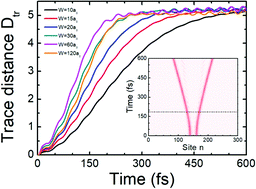Charge-transfer state dynamics in all-polymer solar cells: formation, dissociation and decoherence
Abstract
All-polymer solar cells have made substantial achievements in recent years, offering numerous unsettled subjects for mechanical researchers. In order to quantitatively study the influence of the molecular electrostatic potential on the charge generation proposed by the experimenter, we simulate the ultrafast dynamics of the charge-transfer (CT) state at the interface between two polymer chains, which are respectively regarded as the donor and acceptor in all-polymer solar cells. The formation of a stable CT state is found to be sensitive to the distance between two oppositely charged polarons and the relevant critical electrostatic potential is thus quantified, which is in good agreement with experiments. In order to get insight into the dependence of the dissociation of the CT state on the width of the interfacial layer, two quantities are calculated: one is the Coulomb capture radius between the two polarons and the other is the quantum trace distance which serves as the fingerprint of the quantum coherence between them. The dissociation of the CT state is found to take place within an ultrafast timescale for an optimum interfacial width. The classical spatial distance and the quantum trace distance manifest a converging trend, suggesting a decoherence scenario for the charge separation in all-polymer solar cells.



 Please wait while we load your content...
Please wait while we load your content...